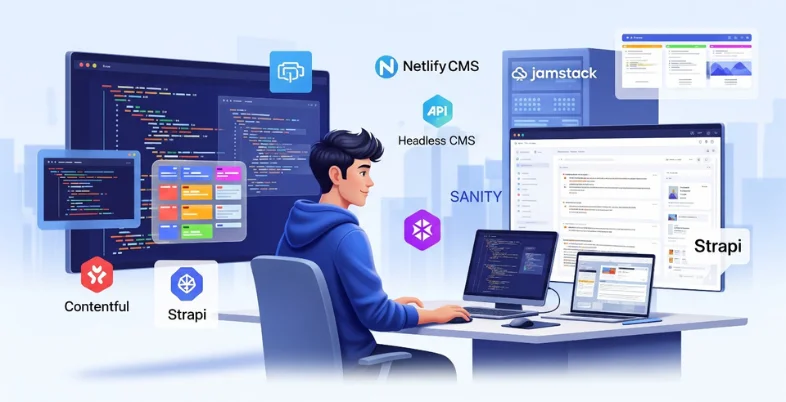The way we build websites is changing fast — and Jamstack is leading the way. More than 60% of developers now use Jamstack to build faster, safer, and more flexible sites. This modern approach uses static site generators and APIs, which means your site loads quicker and is easier to scale.
A big reason for Jamstack’s popularity is the rise of headless CMSs. These new tools help you manage content in one place and deliver it anywhere, without slowing your site down. By 2032, the global headless CMS market is projected to reach $2.2 billion, expanding at a rate of more than 20% annually.
In this guide, you’ll discover the 15 best CMS for Jamstack — with the features, benefits, and links you need to choose the right one for your next project.
How to Choose the Right CMS for Your Jamstack Project
- Define your needs: Decide if you want a fully hosted SaaS CMS or an open-source, self-hosted option.
- Check integration: Make sure the CMS works well with your static site generator (Next.js, Gatsby, Hugo, etc.).
- Look for ease of use: Choose a tool with a clean editor and workflows your team can easily use.
- Think about scale: Pick a CMS that handles multi-language content, roles, and permissions if you plan to grow.
- Review pricing: Compare free plans, open-source options, and paid tiers to fit your budget.
Why Use a Headless CMS with Jamstack
- Speed and performance: Static sites load fast and deliver great user experiences.
- Better security: No direct database or server for hackers to target.
- Flexible content delivery: Publish once, display anywhere — web, app, or IoT.
- Developer freedom: Build with your favorite frontend tools and frameworks.
- Easy scaling: Handle spikes in traffic without worrying about backend bottlenecks.
List of Top 15 Best CMS for Jamstack
1. Netlify CMS
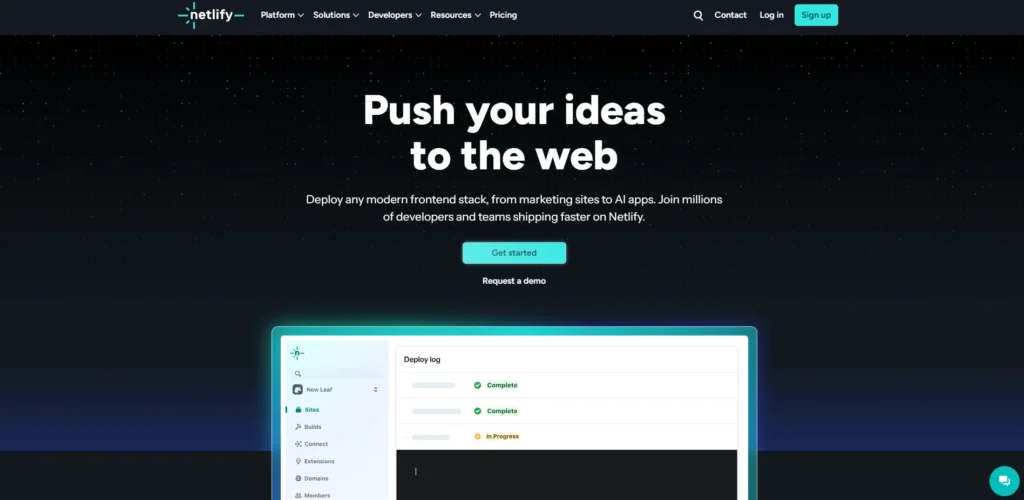
Netlify CMS Studio is a free and open-source content management software that was designed to integrate with contemporary static site generators, such as Gatsby, Hugo, Jekyll, etc. Compared to the classic CMS systems that depend on the server-side backend immensely, Netlify CMS is a one-page React application ready to live in your Git workflow. It has a human friendly administration interface that allows content editors to edit and publish contents without necessarily having to access the code.
This implies that developers would be able to use the static site generator to create sites that are quick and secure and non-technical editors would also be provided with a user-friendly interface where they can add or edit the content with the support of the version control. With Netlify CMS, the versioning and collaboration are very easy because it supports GitHub, GitLab, or Bitbucket well.
It has custom content models, media uploads and supports Markdown editing, which is versatile enough to use in blogs, documentation websites or company websites. It is open-source, which means that developers could customize the CMS to the project requirements and improve it in the long-run. Netlify CMS works well on Jamstack sites because it is performance-focused, highly scalable and has excellent editing and tailoring.
Top Features:
- Open-source and Git-based workflow
- Intuitive and customizable admin UI
- Media library with drag-and-drop uploads
- Supports custom content structures
- Integrates with popular static site generators
Website: https://www.netlify.com/
Pricing:
| Free | Pro | Enterprise |
| $0 | $19/mo | Custom |
2. Contentful
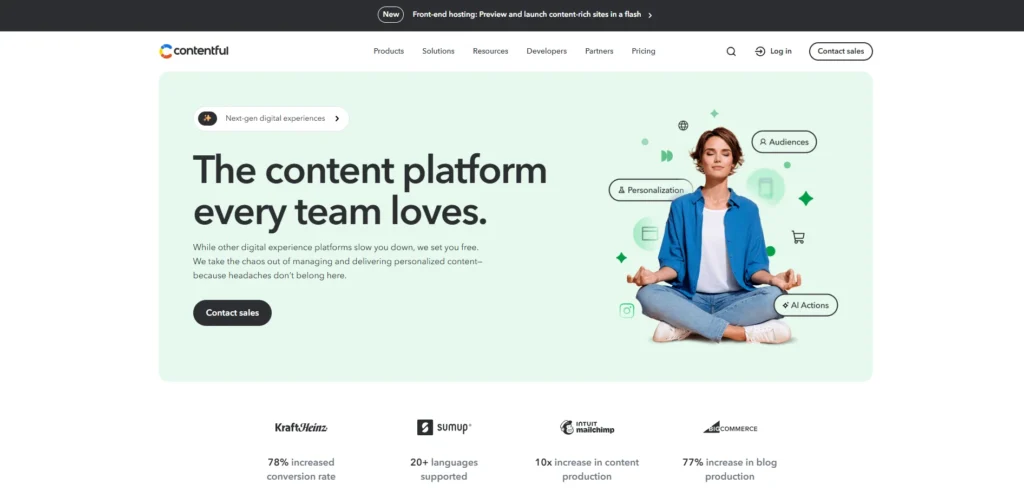
Contentful is one of the newest headless CMSs that works with the Jamstack architecture. It provides API first content platform that renders content applications independent of presentation, as such, the developer can send data to any frontend such as websites, applications, IoTs, or digital signage. It has robust RESTful and GraphQL APIs that ease the querying of content and fast delivery to Web key generators such as Gatsby or Next.js. Moreover, it has tidy, modern editor experience, which allows content managers to handle structured contents.
Contentful is scalable and flexible, which makes organizations love it. You are free to create your custom content models, manage granular roles and permissions, and integrate your content with other services using webhooks or plugins. Multi-language support is also robust, making it a favorite of international brands. It is a SaaS product, but Contentful has an API ecosystem and well-documented APIs that make it friendly to developers and very flexible as part of a CMS for Jamstack, where performance and malleability are paramount.
Top Features:
- API-first, headless architecture
- RESTful and GraphQL APIs
- Custom content types and entries
- Roles, permissions, and localization
- Extensive integrations and webhooks
Website: https://www.contentful.com/
Pricing:
| Free | Lite | Premium |
| $0 | $300/mo | Available on request |
3. Sanity
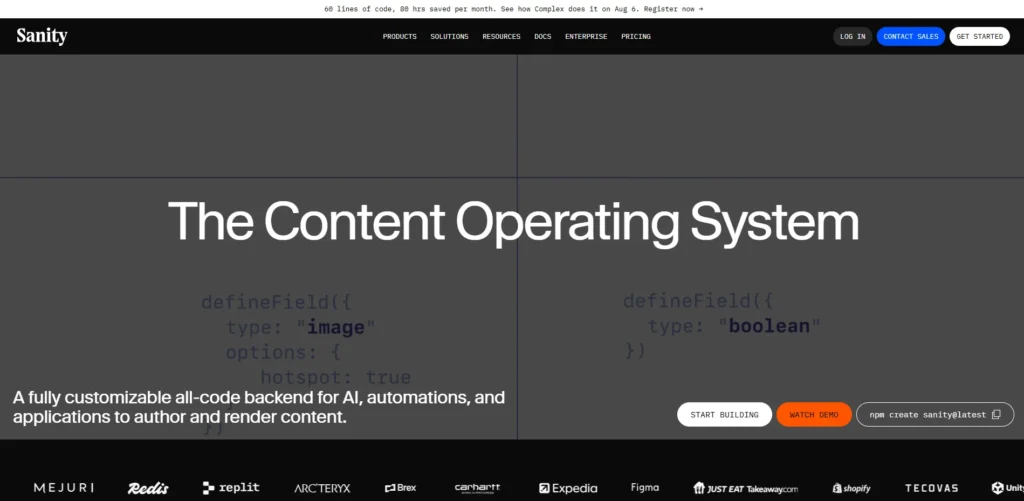
Another great headless CMS is Sanity; it is aimed at those developers who need full control of the way of content structuring, storing, and offering. The unique selling point of Sanity is a possibility of real-time collaboration and high-customizability of the editing environment. The Sanity Studio is a reaction-based environment where we provide an open-source editing environment built on React, not only customizable in terms of input components, workflow and Plugins, but also in the way your team works. It, in turn, is particularly helpful with teams that have complicated editorial workflows.
The APIs of Sanity are in real-time, which means that it is extremely responsive and fast, which is suitable to use with Jamstack websites, where instant previews and up-to-date changes are required. It persists content in a dynamic, queryable document store, and serves the content using an ultra-fast GROQ query language or GraphQL API. The developers could also wish to extend Sanity backend with serverless functions or mix with static site generator/frontend framework. Sanity has an attractive free level and highly active developer community which has made it an option for both startups and large enterprises building Jamstack sites.
Top Features:
- Real-time collaboration and editing
- Highly customizable open-source studio
- GROQ and GraphQL APIs
- Instant content previews
- Rich plugin ecosystem
Website: https://www.sanity.io/
Pricing:
| Free | Growth | Enterprise |
| $0 | $15/mo | Custom |
4. Strapi
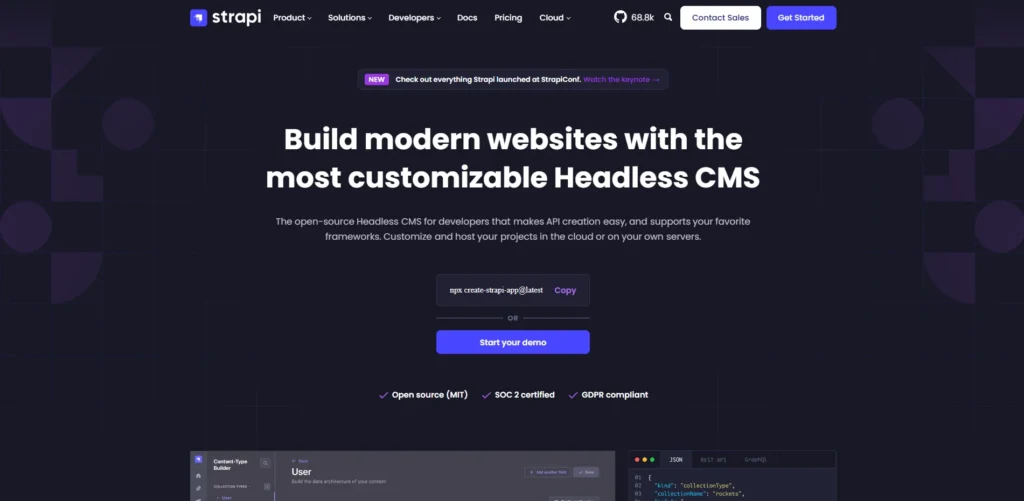
Strapi is one of the most popular open-source headless content management systems that allow developers to have full control over their own API and content structure. Strapi is designed with the help of Node.js, which helps easily structure flexible APIs to distribute content to Jamstack frontends. As one of the most developer-friendly content distribution platforms, it enables efficient delivery of content across multiple channels. It is self-hosted by nature, thus you own your data and can deploy it anywhere: in the cloud, on premise or a serverless environment. This is very advantageous to developers wishing to optimise performance, security, or deployment pipelines.
Strapi is delivered with a beautiful admin panel, which makes it easy to manage content, media and user roles by content teams. It has native support of both REST and GraphQL APIs and the plugin system suggests the ability to perform custom extensions when required whether it is to connect with the third-party services, providing authentication support or automating the processes. Strapi will never lose due to its strong community, frequent development, and thriving ecosystem, which makes the platform a reliable CMS not only to developers who want to create fast, secure, and scalable Jamstack sites.
Top Features:
- Open-source and self-hosted
- REST and GraphQL APIs
- Customizable admin panel
- Role-based access control
- Plugin marketplace
Website: https://strapi.io/
Pricing:
| Community | Growth | Enterprise |
| $0 | $15/mo | Available on request |
5. Prismic
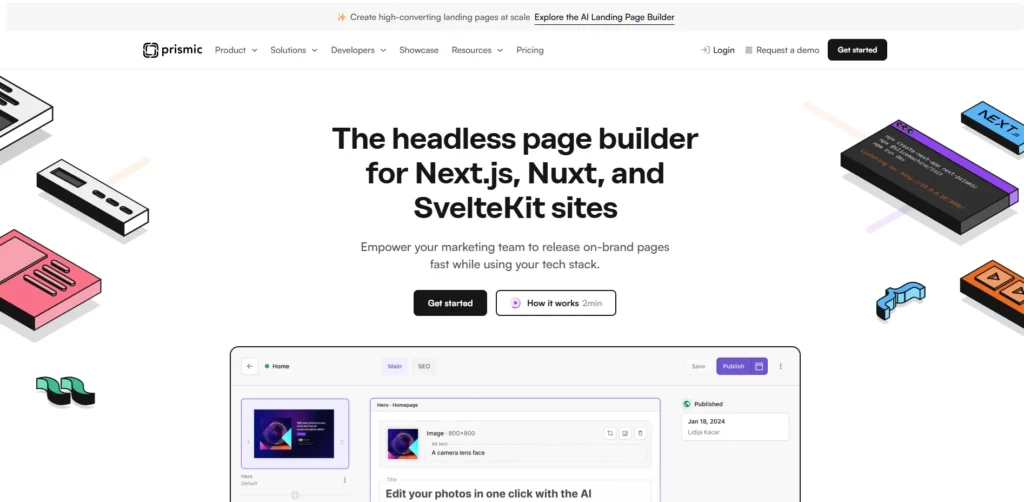
Prismic is a headless CMS designed to help programmers and marketer working together on Jamstack-based websites. Its Slice Machine is what makes it unique – the developers can create site components (Slices) that can be reused and then the web content editors can combine them in new ways to create additional pages without requiring further developer effort. This enables marketing teams to implement landing pages quicker and also regulate structure of designs. The prismic content API is reputed to be extremely speedy and developer-friendly and is compatible with static site generators such as Next.js and Gatsby.
Prismic provides a stunning web interface to manage and schedule the contents as well. Editors get a real-time preview of the changes, and the built-in publishing workflow allows planning the releases. Its high level of integration, together with detailed documentation, makes it conducive to integrate Prismic into your Jamstack tech stack. Prismic offers multiple paid options to scale projects and a generous free usage, and can remain a good option in case teams are interested in a compromise between designer and developer agency.
Top Features:
- Slice Machine for reusable website sections
- Intuitive editing and publishing workflow
- Real-time previews
- Fast REST and GraphQL APIs
- Extensive integration guides
Website: https://prismic.io/
Pricing:
| Free | Medium | Platinum | Enterprise |
| $0/mo | $150/mo | $675/mo | Custom |
6. Ghost
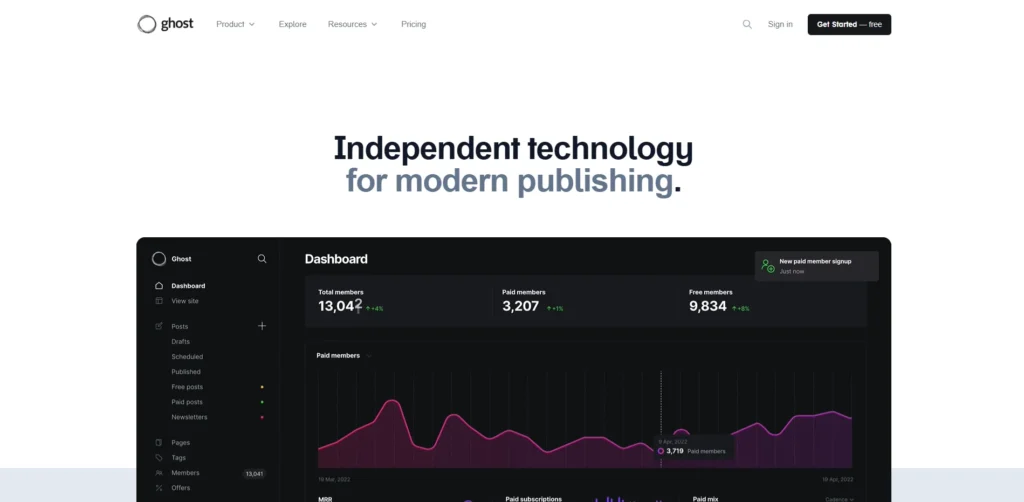
Ghost is a popular open-source headless CMS originally created for bloggers and online publications but now widely used for Jamstack sites too. It offers a modern, minimalist admin dashboard that lets writers and editors focus on content creation without distractions. Ghost uses a robust REST API and a flexible Content API that makes it easy to connect with static site generators like Gatsby or Next.js, turning your site into a blazing-fast static build with dynamic content updates handled via APIs.
Ghost also shines in the area of membership, subscriptions, and newsletters. It has built-in support for paid memberships and native email newsletters, which is perfect for content-driven businesses and independent creators looking to monetize their audience. With the rise of AI content writing tools, Ghost integrates well into modern workflows where automation and efficiency in publishing are key. Developers appreciate Ghost’s clean Node.js codebase, extensive theme marketplace, and easy integrations with popular Jamstack tools. Whether you’re running a blog, a media site, or a membership site, Ghost gives you full control over both content and audience relationships in a Jamstack-friendly way.
Top Features:
- Open-source and built with Node.js
- RESTful Content API and Admin API
- Native membership and subscription features
- Inbuilt email newsletter system
- Clean and modern admin interface
Website: https://ghost.org/
Pricing:
| Starter | Creator | Team | Business |
| $9/mo | $25/mo | $50/mo | $199/mo |
7. ButterCMS
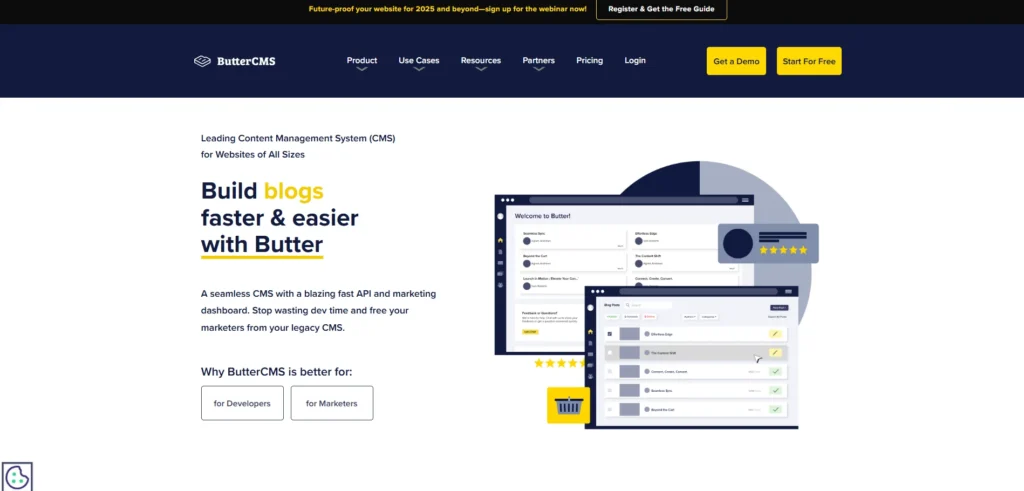
ButterCMS is a fully-hosted and headless content management system that is easy to use by both developers and marketing teams. Among its most unique aspect is that it is a plug and play, that is, it can be easily integrated with other software and able to work with the static site generators, and front-end frameworks so it would naturally be used in Jamstack projects. ButterCMS offers flexible content modeling, a rich text editor, search engine optimization (SEO) and simple content creation, editing and structuring tools accessible to non-technical editors.
ButterCMS is excellent in terms of performance and flexibility. As it is fully managed, there is no hosting, scaling and maintenance to deal with, as it is all offloaded to the ButterCMS API. It has multi-site and multi-language capabilities, which are ideal when dealing with companies that have worldwide markets or those that have several brands. It has a strong API, good documentation, and a speedy CDN delivery that enables developers to create high-performing static websites, easily updateable and scaleable, and at the same time provide content editors with the necessary resources to publish their work within a short time.
Top Features:
- Fully-hosted, headless, and API-first
- Easy integration with static site generators
- SEO and blogging capabilities built-in
- Multi-site and multi-language support
- Rich, user-friendly editing dashboard
Website: https://buttercms.com/
Pricing:
| Micro | Startup | Small Business | Enterprise |
| $99/mo | $199/mo | $375/mo | Available on request |
8. Publii
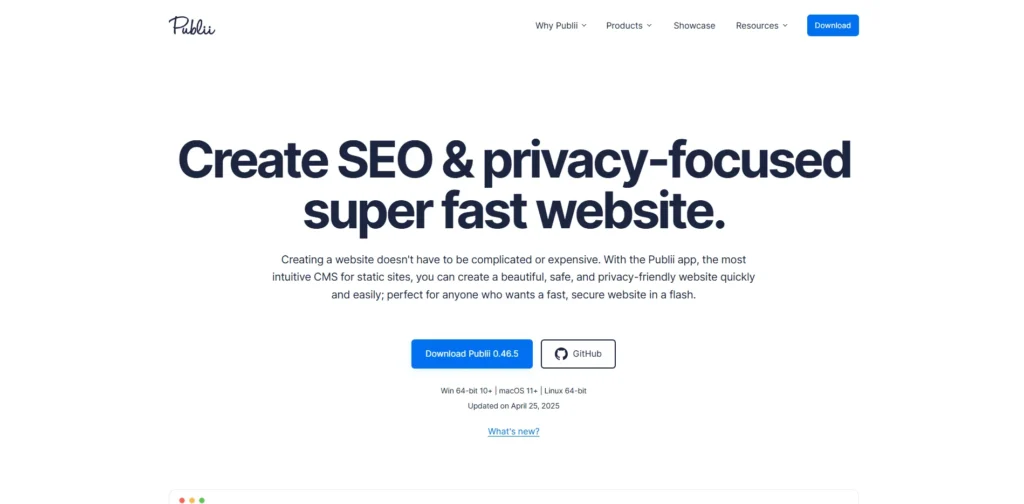
Publii is a unique static site CMS designed for users who want the simplicity of a desktop app and the power of Jamstack architecture. Unlike traditional headless CMSs that run on the web, Publii is an open-source desktop application that lets you build, manage, and update static websites right from your computer. Once you’re done editing, you can deploy your site to Netlify, GitHub Pages, or any static hosting provider with a single click.
Publii is especially popular among bloggers and small business site owners who want the speed and security of a static site without touching code every time they make changes. The user interface is beginner-friendly, supports custom themes, built-in SEO tools and settings, and offline editing — so you can write and update content even when you’re not connected to the internet.
Top Features:
- Desktop app for managing static sites
- One-click deployment to static hosts
- SEO settings and custom themes
- Offline editing and backups
- Beginner-friendly with no server needed
Website: https://getpublii.com/
Pricing:
- Available on request
9. Storyblok
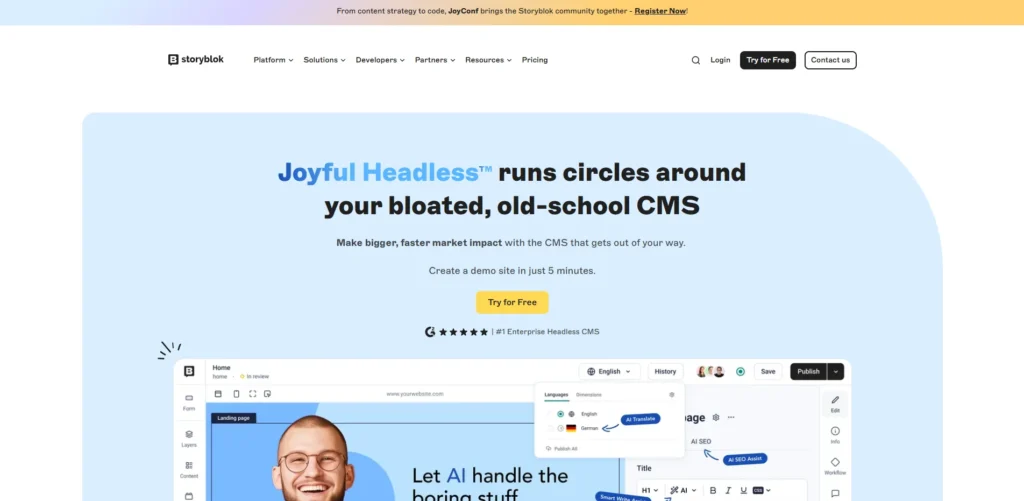
Storyblok is an advanced visual headless CMS for Jamstack that is built to be developer-flexible — the perfect combination to build Jamstack websites. It has an outstanding feature, namely, its visual editor that allows content creators to see real-time updates as they edit, which uses a component approach. Web developers can create blocks of content that can be either re-used or mixed and matched with other blocks of content to make new pages or arrangements, conserving design and drastically reducing the time needed to maintain the site.
The headless architecture of Storyblok implies that all contents are served through a stable API, and a developer can connect with static site generators, such as Next.js, Gatsby, or Nuxt. The CMS is multi-lingual containing complex custom fields, user roles and a blooming world of integrations and plugins. Storyblok, with its rich documentation and a strong community, combined with exceptional scale, is a highly logical alternative to startups and enterprises interested in the creation and management of Jamstack sites requiring developer freedom, as well as a comfortable experience with an editor.
Top Features:
- Visual editor with real-time preview
- Component-based content management
- API-driven headless architecture
- Multi-language and localization support
- Custom workflows and user roles
Website: https://www.storyblok.com/
Pricing:
| Growth | Growth+ | Premium |
| $99/mo | $349/mo | Custom |
10. DatoCMS
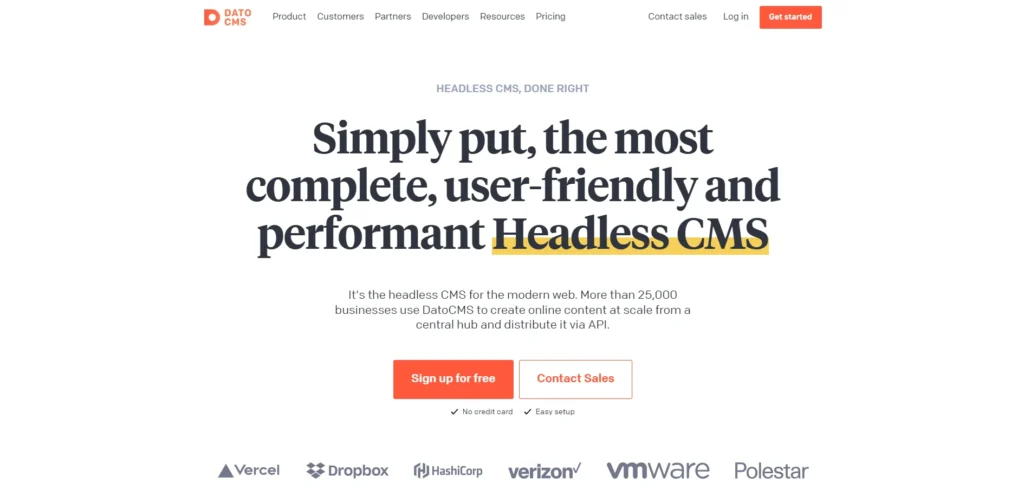
DatoCMS is a headless CMS that is both fresh and developer-friendly and therefore fits in Jamstack workflows perfectly. It has a dynamic API to distribute content on any frontend-be it the static site generator like Gatsby or Next.js or even a mobile application. The reason DatoCMS is special is its powerful image API that automatically prefers optimization and generation of responsive sizes-talk-of-town in terms of site speed with Jamstack. It features an easy to operate the admin interface and the custom fields, as well as model validations enable editors to organize content in a well-structured way.
The real-time GraphQL API used by DatoCMS is one of the greatest strengths because the queries of content are speedy and efficient. It allows localization, role-based permissions, webhooks and even plug-ins which enables developers to extend and automate workflow. DatoCMS also does the magic of CDN distribution and asset management when not to mention global performance and reliability. DatoCMS can be recommended due to strong documentation, flexible plans, and increasing popularity, which makes it perfect to go with teams that are interested in fast, scalable, and editor-friendly Jamstack projects.
Top Features:
- Real-time GraphQL API
- Powerful image optimization API
- Flexible content models and field validations
- Localization and role-based access
- Automatic CDN delivery for fast performance
Website: https://www.datocms.com/
Pricing:
| Professional | Enterprise |
| $149/mo | Custom |
11. Agility CMS
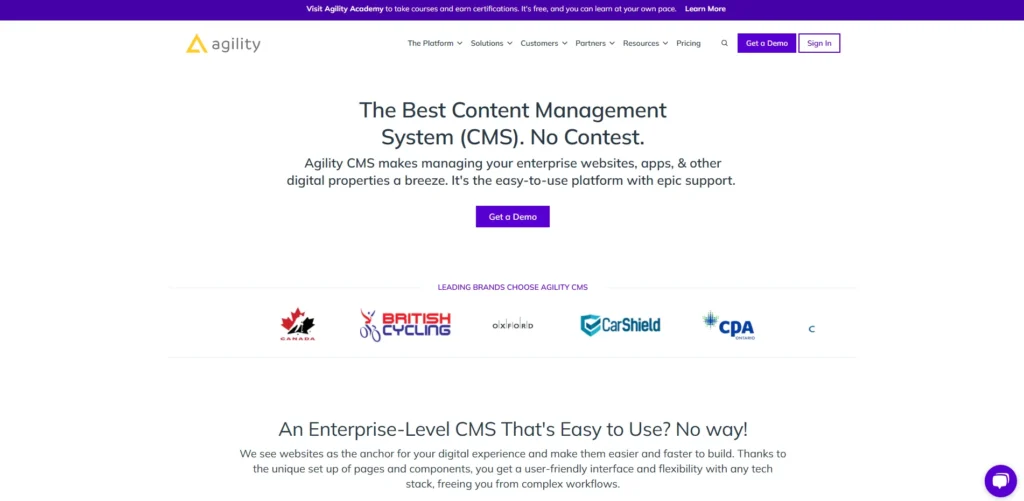
Agility CMS is a robust, API-first headless CMS that’s been around since 2002 — long before “headless” became a buzzword. It’s designed to empower both developers and marketers working on Jamstack sites. Agility CMS blends the contemporary adaptability of a headless design with conventional content management tools (such as page management and sitemaps). This means your team can structure content once and deliver it anywhere — static sites, apps, or digital displays — while enjoying the performance benefits of a static site generator like Gatsby or Next.js.
What makes Agility CMS stand out is its hybrid approach: it blends headless CMS flexibility with some features you’d expect from legacy platforms, like built-in page management and dynamic routing. This is a big plus for non-technical teams who want more control over page layouts without asking developers for every small change. With built-in localization, a rich API, powerful workflows, and a strong emphasis on security and scalability, Agility CMS is a solid option for businesses that want the best of both worlds in a Jamstack setup.
Top Features:
- Hybrid headless CMS with page management
- RESTful and GraphQL APIs
- Built-in localization and content modeling
- Advanced workflow and permissions
- Integrates with static site generators easily
Website: https://agilitycms.com/
Pricing:
| Free | Starter | Pro | Enterprise |
| $0 | $1249/mo | $2499/mo | Available on request |
Also Read: Website Analytics Tools
12. Cosmic
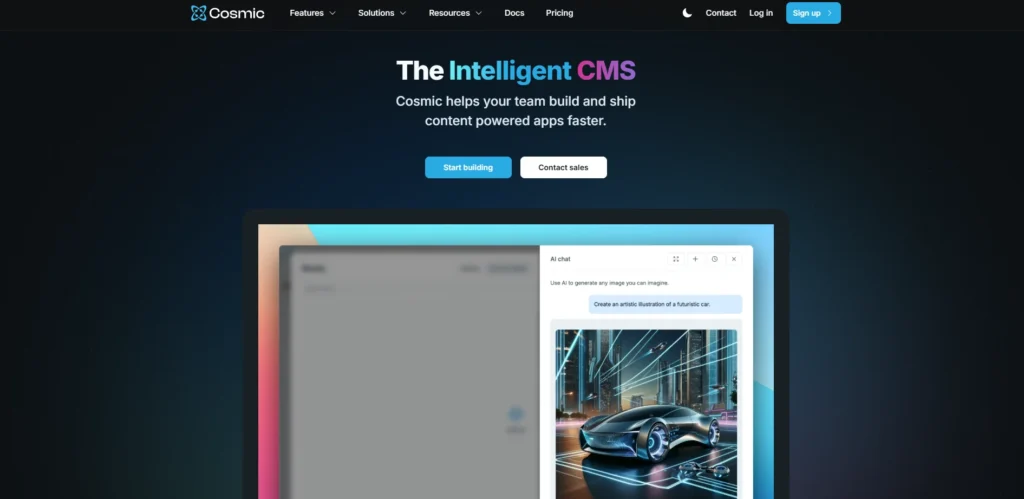
For Jamstack developers, Cosmic is a lightweight, API-first headless CMS that prioritizes ease of use and speed. With Cosmic, content is delivered via a powerful REST or GraphQL API, and your site’s presentation layer can be built using any technology stack — whether it’s Gatsby, Next.js, or a custom static site workflow. The Cosmic dashboard is sleek and straightforward, allowing non-technical users to manage content, media, and metadata with ease.
Cosmic’s bucket structure makes it easy to organize different content types, from blog posts to product pages, while developers appreciate the ease of setting up dynamic content and scaling projects. The platform’s global CDN ensures lightning-fast delivery of assets and API responses, which aligns perfectly with the performance-focused Jamstack approach. Add webhooks, extensions, and single sign-on, and you have a CMS that scales from simple projects to complex sites without added bloat.
Top Features:
- Simple, intuitive interface for editors
- RESTful and GraphQL APIs
- Global CDN for asset delivery
- Flexible bucket and content modeling
- Extensible with webhooks and extensions
Website: https://www.cosmicjs.com/
Pricing:
| Free | Starter | Pro |
| $0 | $299/mo | $499/mo |
13. TinaCMS
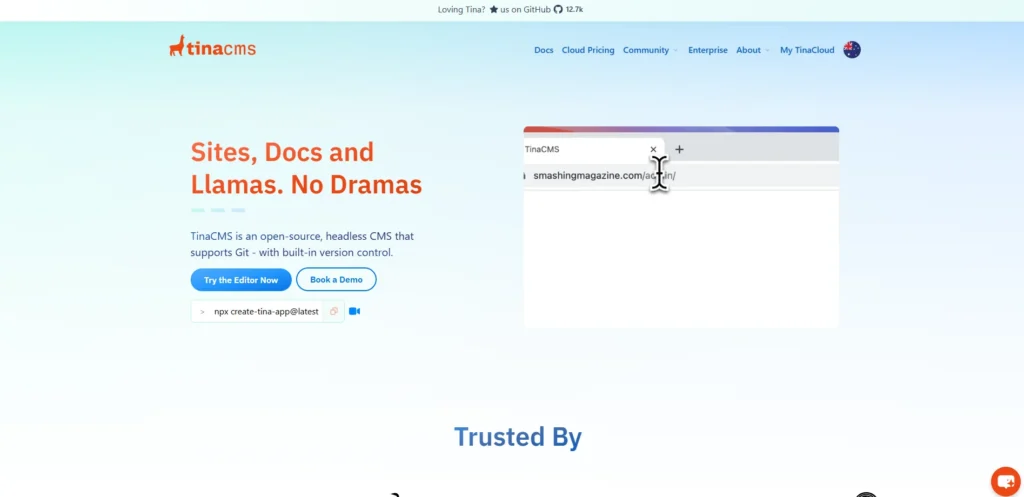
TinaCMS is an open-source, Git-backed CMS that brings visual editing to Jamstack projects. Unlike some headless CMSs that rely on remote APIs, TinaCMS works directly within your site’s Git workflow — giving developers and content creators an inline editing experience right on the live site or in a staging environment. It works perfectly with static site generators like Next.js, Hugo, and Gatsby, keeping content version-controlled and easy to deploy.
What makes TinaCMS special is its live editing approach. Editors can see their content changes as they type, preview new pages, and commit updates straight to GitHub or GitLab. This tight coupling between the CMS and the codebase helps teams maintain site performance, security, and workflow simplicity. TinaCMS is highly customizable and has a growing ecosystem of plugins and community support. It’s an excellent choice for Jamstack teams who love Git-based workflows but want a friendly editing experience too.
Top Features:
- Visual inline editing on live sites
- Git-backed content workflow
- Works with Next.js, Hugo, Gatsby, and more
- Open-source and highly customizable
- Growing community and plugin ecosystem
Website: https://tina.io/
Pricing:
| Free | Team | Team+ | Business | Enterprise |
| $0 | $24/mo | $41/mo | $249/mo | Custom |
14. Directus
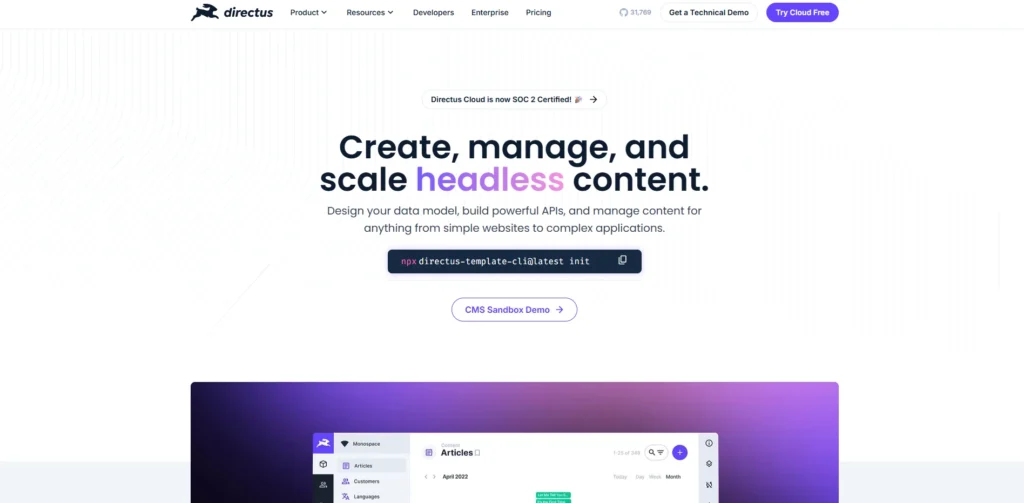
Directus is a special open-source data platform that serves as a data API layer for any SQL database as well as a headless CMS. Unlike most headless CMSs that store content in their own system, Directus connects directly to your existing database — whether it’s MySQL, PostgreSQL, or SQLite — and instantly generates a dynamic API. This makes it incredibly powerful for Jamstack sites that need to handle complex or large-scale data while staying performant and flexible.
Directus provides an intuitive admin app where teams can manage database content visually without writing SQL queries. It supports custom data models, granular permissions, asset management, and real-time GraphQL or REST APIs. Developers love Directus for its full control over data architecture, while editors appreciate the friendly UI. This makes Directus an outstanding choice for Jamstack teams that want to unify CMS and database management in one modern, open-source platform.
Top Features:
- Connects to any SQL database
- Automatic REST and GraphQL API generation
- Visual admin interface for non-technical users
- Role-based access and advanced permissions
- Open-source and self-hosted
Website: https://directus.io/
Pricing:
- Available on request
15. Kentico Kontent
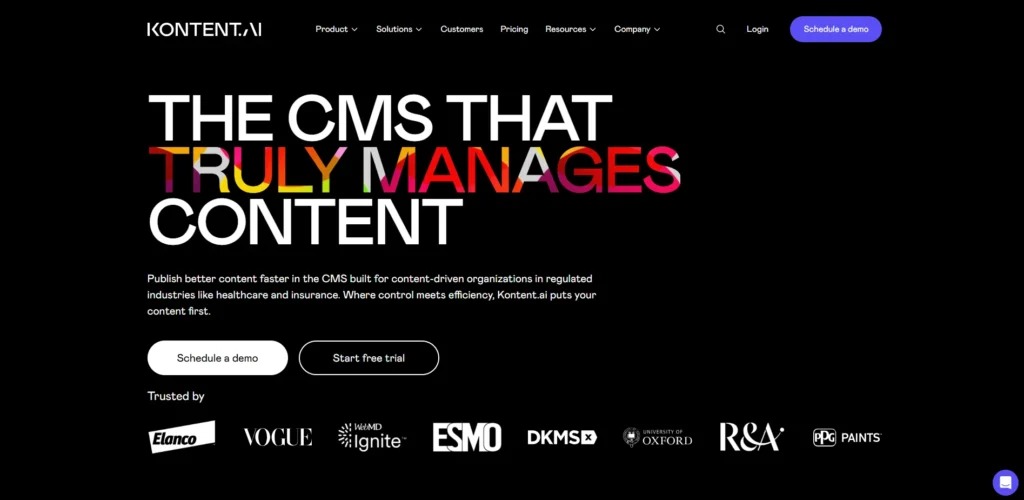
Kentico Kontent is an enterprise-grade headless CMS designed for large-scale Jamstack websites and digital experiences. It delivers a strong combination of flexible content modeling, API-driven delivery, and advanced collaboration tools for content teams. Developers can connect Kentico Kontent to static site generators like Gatsby or Next.js using its robust REST and GraphQL APIs, ensuring that static builds get the freshest content without slowing down the site.
What makes Kentico Kontent popular with large organizations is its extensive workflow and governance tools — including roles, permissions, versioning, scheduling, and multi-language support. It integrates with popular CI/CD pipelines and can scale to handle complex multi-site setups. Editors benefit from an intuitive interface, real-time previews, and easy collaboration tools that streamline content production and approval processes. For Jamstack teams that need security, scalability, and a world-class editorial experience, Kentico Kontent is a reliable choice.
Top Features:
- Enterprise-ready headless CMS
- REST and GraphQL APIs
- Strong content modeling and localization
- Advanced workflow, roles, and permissions
- Real-time preview and scheduling
Website: https://kontent.ai/
Pricing:
- Custom
Conclusion
In conclusion, we now have quicker, safer, and more adaptable websites than ever before thanks to the Jamstack methodology, which is here to stay. To keep information current and manageable, even the greatest Jamstack website requires a robust content management system. The correct CMS for Jamstack can help you save time, improve team productivity, and ensure that your website functions properly, regardless of whether you’re creating a small blog or a large corporate website.
You’ll be prepared to create incredible things on the Jamstack if you take the time to consider the best solutions and match their characteristics with the requirements of your project.
FAQs
1. Do I Need Coding Skills to Use a CMS for Jamstack?
Not always! Many modern CMSs offer user-friendly editors and dashboards for non-developers, but setting up the initial integration usually needs some developer help.
2. Can I Switch My Site to Jamstack Without Starting Over?
Yes, many sites migrate to Jamstack by connecting their existing content to a new headless CMS and static site generator. It takes planning, but it’s possible without a full rebuild.
3. Are Headless CMSs Safe and Secure?
Yes — because there’s no server-side rendering by default, your site has fewer entry points for hackers. Plus, many CMS providers offer extra security features and reliable backups.
